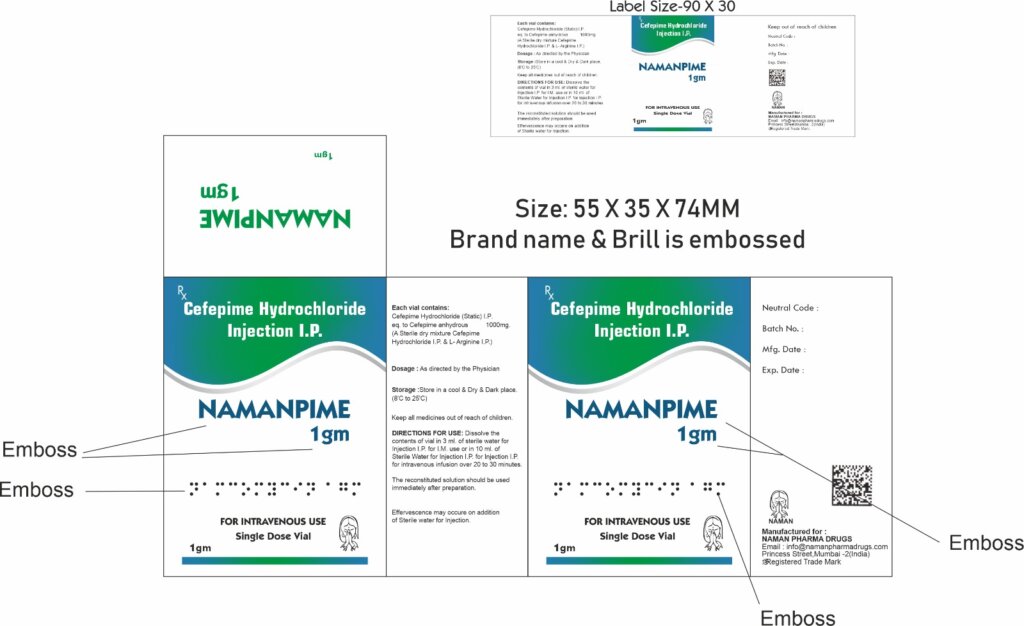
Namanpime – cefepime Hydroclhoride Injection I.P
Each vial contains :
Cefepime Hydroclhoride (Static) I.P
Dosage : As directed by the Physician .
Storage : Store in a cool, Dry and Dark place .( 8’C to 25’C)
Keep all medicines out of children.
Directions for use : Dissovle the contents of vial in 3 ml. of sterile water for Injection I.P. for I.M) use or in 10 ml. of Serile Water for Injection I.P. for intravenous infusion over 20 to 30 minutes.
Namanpime Cefepime Hydrochloride Injection I.P (Intravenous or IV) is a medication used to treat various bacterial infections. It contains cefepime, which is a broad-spectrum cephalosporin antibiotic. Here’s some important information about Cefepime Hydrochloride Injection I.P:
Indications: Cefepime is prescribed by healthcare providers to treat a wide range of bacterial infections, including:
1. Respiratory Tract Infections: Such as pneumonia, bronchitis, and lung abscesses.
2. Urinary Tract Infections: Including complicated urinary tract infections.
3. Skin and Soft Tissue Infections: Such as cellulitis and wound infections.
4. Intra-abdominal Infections: Including peritonitis.
5. Bloodstream Infections: Such as septicemia.
6. Bone and Joint Infections: Including osteomyelitis.
Dosage: The dosage of Cefepime Hydrochloride Injection varies depending on the type and severity of the infection, the patient’s age, weight, and renal function. It is typically administered by a healthcare professional through intravenous (IV) infusion. The dosage and administration schedule will be determined by your healthcare provider.
Frequency: Cefepime is usually given once every 12 or 24 hours, depending on the specific infection and patient characteristics. It’s essential to follow the prescribed dosage and administration schedule.
Precautions:
1. Allergies: Inform your healthcare provider of any known allergies to antibiotics, especially cephalosporins or penicillins.
2. Kidney Function: If you have impaired kidney function, your healthcare provider may need to adjust the dosage of Cefepime accordingly.
Side Effects: Common side effects of Cefepime may include nausea, vomiting, diarrhea, headache, and injection site reactions. Serious allergic reactions or adverse effects on the liver or blood can occur but are rare. If you experience severe diarrhea or any other unusual symptoms while taking Cefepime, contact your healthcare provider.
Duration of Treatment: The duration of treatment with Cefepime depends on the type and severity of the infection. It is essential to complete the full course of treatment as prescribed, even if symptoms improve before finishing the medication.
Storage: Cefepime Injection should be stored according to the manufacturer’s instructions, typically at controlled room temperature, protected from light. Follow proper storage guidelines to maintain the medication’s effectiveness.
Safety: Cefepime should only be used under the supervision of a healthcare provider, and it should not be shared with others. It’s important to follow all instructions and take the full course of antibiotics to prevent the development of antibiotic resistance.
Adverse Reactions: While Cefepime is generally well-tolerated, it can have serious side effects or allergic reactions in some cases. If you experience any unusual symptoms or side effects, seek medical attention immediately.
Always consult with a healthcare professional for specific information about the use of Cefepime Hydrochloride Injection I.P or any other medication, as individual circumstances may vary, and medical guidance is essential for safe and effective treatment.
